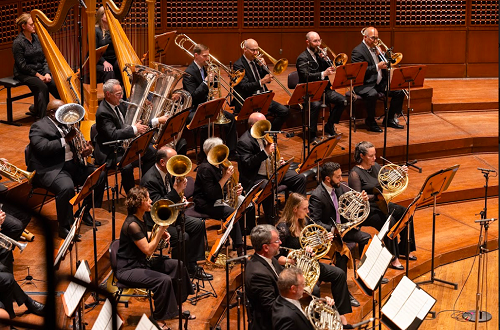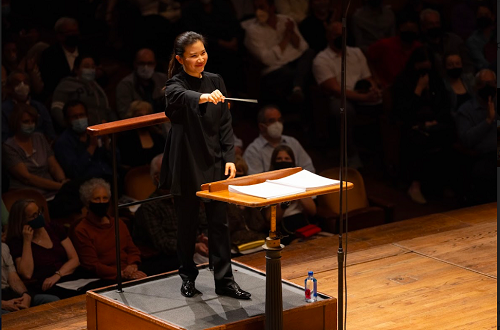 United States Various: National Brass Ensemble / Eun Sun Kim (conductor). Davies Symphony Hall, San Francisco, 20.6.2022. (HS)
United States Various: National Brass Ensemble / Eun Sun Kim (conductor). Davies Symphony Hall, San Francisco, 20.6.2022. (HS)

R. Strauss – Vienna Philharmonic Fanfare
Jonathan Bingham – DEIFIED (world premiere)
Arturo Sandoval – Brass Fantasy (world premiere)
Wagner (arr. Timothy Higgins) – The Ring (world premiere)
In its first live appearance in seven years, the National Brass Ensemble made a big impact Monday in a concert that included three world premieres. All are being recorded this week and, judging by the welcome they got from an enthusiastic audience filled with plenty of musicians, the results should be well worth savoring.
Assembled in 2013 to record a well-received album of music by Gabrieli (and give a series of concerts), the band comprises key players from major symphony orchestras, including an impressive lineup of principals. The brainchild of San Francisco Conservatory president David H. Stull and Cleveland Orchestra principal trumpet Michael Sachs, the group focused this time on new works by film composer Jonathan Bingham, Latin jazz great Arturo Sandoval and Timothy Higgins, San Francisco Symphony’s principal trombone.

They also got Eun Sun Kim, music director of San Francisco Opera, to conduct. She embedded subtlety between the brilliant outbursts we expect from brass music in the two-and-a-half-hour program.
Richard Strauss’s Vienna Philharmonic Fanfare got the concert off to a rousing start, a fine way to appreciate the sonorities and subtle articulation these musicians bring to a big brass band.
Bingham’s DEIFIED, a 2021 commission from the San Francisco Conservatory of Music’s Emerging Black Composers Project, came next. The title reflects the palindromic nature of the piece, inspired by the unconventional narrative of the film Memento. The composer liked the way the story was told in short scenes, some moving the narrative forward in time, others backwards. Emerging out of an introduction filled with tone clusters, DEIFIED begins with choppy rhythmic riffs. The next ‘chapter’ sneaks in strands of a lyric, legato theme, at first like a soft countermelody. As the piece progresses, the lyric elements increasingly come to the fore, and the rhythmic phrases act more like accompaniment, reaching a majestic climax.
As clever as that was, the best part of Bingham’s work was the ear-catching musical material. Amid plenty of pungent harmony there was always a clear melodic line to a sense of forward motion.
Sandoval, himself a trumpet player, received the Presidential Medal of Freedom in 2015 for his pathbreaking career melding jazz with his Cuban roots, classical music and rock. Brass Fantasy centers on a recurring lyric tune that might have been penned by a Broadway composer in the 1940s or 1950s, gradually taking on Bach-like counterpoint as it gains rhythmic momentum, until the Baroque elements dominate the second half of the piece.
Despite Sandoval’s Cuban roots, references to Latin rhythms are subtle – perhaps an accent here and there in the counterpoint. Even without conga drums or other island percussion, nor specifically Latin rhythms, the music moves with a sense of purpose. It made my head want to bounce along with it.
Timothy Higgins made a splash in his trombone concerto with the San Francisco Symphony earlier this season (click here for a review). He isn’t the first musician to wrangle Wagner’s 17 hours of music for Ring of the Nibelungen into an hour or so of continuous highlights. Famously, conductor Lorin Maazel assembled high points of the score into a 75-minute opus titled Der Ring ohne Worte: The Ring Without words (1988).
Higgins, as might be expected, homed in on the segments that make the most extensive use of brass. That is a lot of material, of course, since Wagner himself expanded the orchestra’s standard brass section with Wagner tubas, bass trumpets, contrabass trombones and extra French horns. He assigned many of the central motifs to specific brass instruments, sometimes the entire brass choir in such moments as the ‘Valhalla’ finale to Das Rheingold and the spine-tingling climax to Siegfried’s funeral music in Götterdämmerung.
Those, of course, are touchstones along Higgins’ own 70-minute tour of Ring music. Like Maazel’s, this tour follows the operas’ timeline in order. The ensemble played the hell out of all of them, with richly textured sound and muscle, but even more fascinating was how Higgins used brass instruments to capture the essence, if not the precise sound, in passages Wagner assigned to woodwinds, strings and even the human voice. A trilling muted trumpet ably stood in for string trills, and piccolo trumpets conjured the sound of high woodwinds in key ensembles. Demondrae Thurman, professor of music at Indiana University, voiced some of Siegfried’s and Wotan’s melodic lines on the euphonium, the instrument’s unique timbre standing out clearly.
And there was Davies Hall’s magnificent Ruffatti organ, with its clarity of tone and deft flexibility, as Jonathan Dimmock underpinned the low E flat that begins the Ring (doubled by two tubas) and later wove melodic strands Wagner wrote for strings into the texture.
Nathaniel Silberschlag, principal horn of the Cleveland Orchestra, walked offstage to deliver Siegried’s horn calls from both Siegfried and Gotterdämmerung with enviable precision and flair. The whole trumpet section, led by Sachs as principal, created magical moments with appearances of the Rheingold ‘Sword’ motif, and the trombones made spooky music of the recurring ‘fate’ motif.
For the most part, Higgins’ score engineers smooth transitions, making for an effortless ride through the music, while Kim’s conducting delineated contrasts that avoided what might have had too much sameness. Especially smile-inducing was the scherzo-like nature of the final sections of Siegfried, which followed the growling weight of the dragon’s music by only a few minutes.
For an encore, the 25-piece band arrayed itself into a long arc across the stage to play Giovanni Gabrieli’s ‘Canzon per Sonare’ No.2, a suitable exclamation point for this rousing concert.
Harvey Steiman